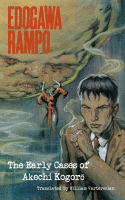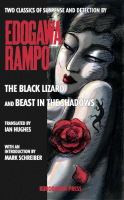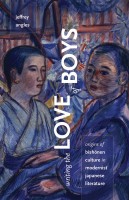 Author: Edogawa Rampo
Author: Edogawa Rampo
Translator: William Varteresian
U.S. publisher: Kurodahan Press
ISBN: 9784902075625
Released: November 2014
Original release: 1925-1926
Edogawa Rampo, the pen name of Hirai Tarō, was an extraordinarily influential author in Japan, especially when it came to the genre of detective and crime fiction. His influence can still be seen to this day and his work continues to inspire other creators. One of his most famous characters is the detective Akechi Kogorō. Previously, only a handful of stories featuring Akechi had been translated into English: “The Psychological Test,” found in Japanese Tales of Mystery and Imagination; The Black Lizard, which was collected in a single volume along with Beast in the Shadows; “The Stalker in the Attic,” published in The Edogawa Rampo Reader; and The Fiend with Twenty Faces. I have always wished for a volume entirely devoted to Akechi mysteries and so I was very happy when Kurodahan Press announced The Early Cases of Akechi Kogorō. Published in 2014 with translations by William Varteresian, the anthology collects four of the earliest Akechi stories written between 1925 and 1926.
After an excellent and informative introductory essay about Edogawa Rampo and Akechi Kogorō, The Early Cases of Akechi Kogorō opens with Rampo’s very first mystery featuring Akechi, “The Case of the Murder on D. Hill,” a short story about the death of Akechi’s childhood friend, the wife of an owner of a secondhand bookshop he frequents. Rampo hadn’t initially intended for Akechi to become a recurring character in his fiction but readers liked him. The second story in the volume, “The Black Hand Gang,” is narrated by the same protagonist as the first, a relatively new acquaintance of Akechi, and the two of them become involved with an investigation into the disappearance of a young relative. In “The Ghost,” Akechi doesn’t appear until rather late in the story to deal with a peculiar case of a wealthy man suffering from a rival’s deep-seated grudge. The volume concludes with The Dwarf, a short novel well-received by the public but apparently disliked by Rampo himself in which Akechi is faced with an increasingly complicated murder mystery with numerous twist and turns.
All four stories in The Early Cases of Akechi Kogorō were written towards the beginning of Rampo’s career. As is noted in the introduction, Rampo largely wasn’t very happy with them. Although The Dwarf became fairly well-known in part thanks to its film adaptations, the cases collected in the volume are generally not examples of Rampo’s best or strongest work, lacking the polish of later stories. An important component of “The Black Hand Gang” doesn’t even translate very well into English since it relies on a cryptographic method based on the Japanese writing systems. Overall, the included mysteries are still enjoyable but somehow not quite as compelling as many of Rampo’s other tales. He would, however, reuse, rework, and refine many of their elements in subsequent writings. One of the things that makes these four stories particularly notable, and the reason that they have been collected together in the first place, is that they reveal Akechi very early on in his development before has become Rampo’s iconic detective and even before his character has been firmly established.
I’ll admit, I like this early Akechi in all of his eccentricities. In “The Case of the Murder on D. Hill” he begins as a well-read and intelligent young man with a particular interest in and fascination with detective and mystery fiction. The small apartment that he rents is so full of books that there’s barely any room to stand, let alone sit or entertain guests. He’s a flashy dresser and an eloquent speaker with a fondness and flair for the dramatic. By the time of The Dwarf, Akechi has begun to transform into the master detective that he will later be remembered as. He is no longer just an amateur sleuth seeking out strange cases in his spare time as some sort of hobby; Akechi has become a skilled and famous investigator with contacts in the judicial and police forces and a cohort of men working under him. I enjoyed The Early Cases of Akechi Kogorō a great deal specifically because it provides a glimpse of the earliest incarnations of Rampo’s great detective. I do hope to have the opportunity to read even more of Akechi’s stories in translation in the future.




